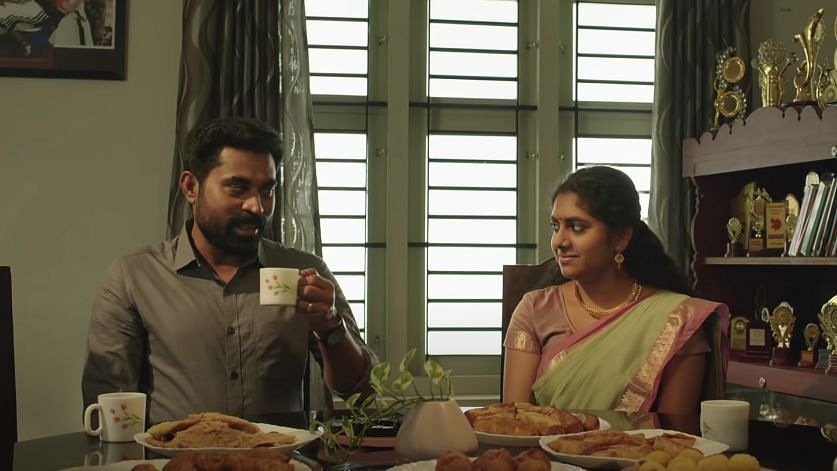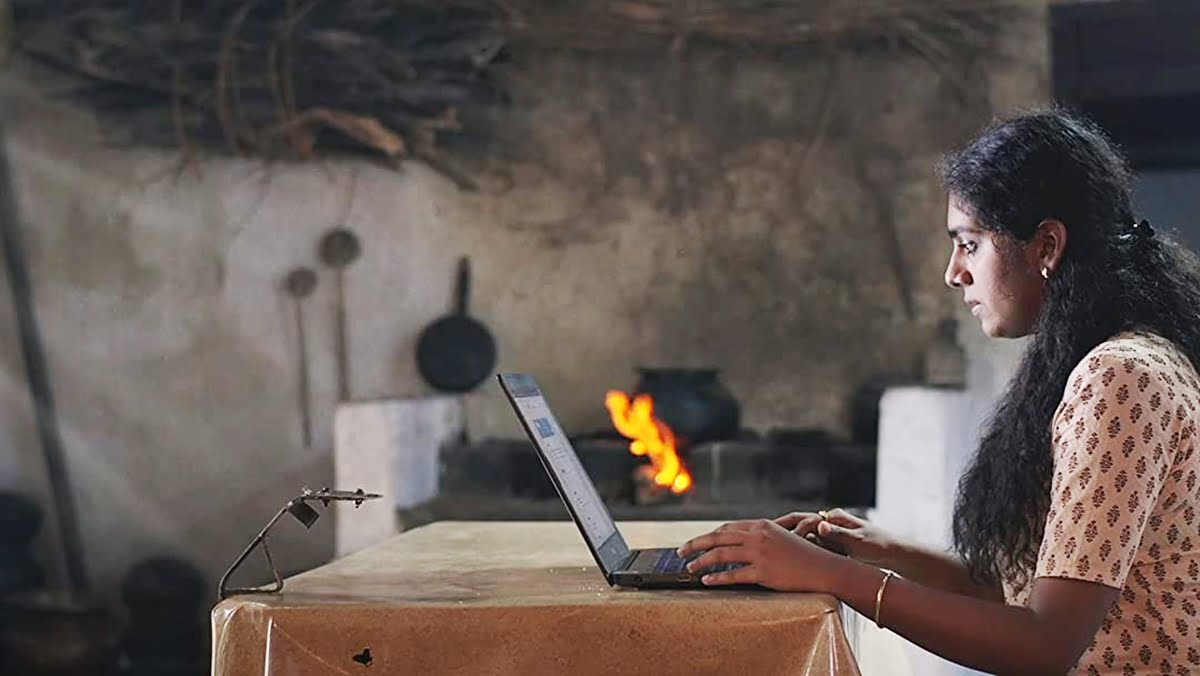Commenting on socio-political issues like patriarchy and sexism without actually commenting on it is no simple feat yet is done perfectly in Jeo Baby’s Mahattaya Bharatiya Adukkala or The Great Indian Kitchen. The critically acclaimed 2021 dramedy is a visual narrative that never addresses the issue it tries to rectify but leaves audiences wanting to rectify it nonetheless.
Baby’s narrative shows the married albeit suffocating life of women in traditional Kerala society as they fall victim to sexism in the household and how it ultimately (in this case) culminates into estrangement and divorce. The cause of this is attributed to the holier-than-thou characteristics of patience and sufferance that the woman of the household lacks, characteristics that she is expected and glorified to possess. I have consciously used the word “women” in the first half of the previous sentence as the film never names its characters and this seems to entail that the characters could be anyone, you or I.
Also read: Analysing Body, Autonomy & Gendered Spaces In The Great Indian Kitchen
One may claim that Baby’s use of the camera is the most impressive aspect of the film. It periodically and repeatedly shows the hegemonic activities women believe themselves to be the performers of, which results in boredom and frustration in the audience, allowing them to empathize with the heroine. However, it is perhaps the gendered spatial placement of his characters that goes unnoticed but requires a much closer study as it provides a deeper understanding of the psyche involved in the male-female dynamic.
The very first instance that attributes to the understanding of this dynamic is one of the most important yet overlooked aspects of patriarchy in traditional Kerala society (and possibly the country as a whole); the Wife is brought to the Husband’s home after marriage. While the Wife does willingly go to her Husband’s abode to live the rest of her life, there are certain habitual and behavioral changes she is forced to make in order to adjust to the masculine household.

For example, the Husband’s father prefers to have his chutney grinded on stone rather than with an electric grinder and wants his rice cooked on wood rather than in a pressure cooker. It would be easier to use the electronic equipment in both instances, but the women are forced to exert more physical energy to please the patriarch. In this manner, she is molded to lose her way of doing chores and is ‘mansplained’ how a particular work should be done even if that work has been stereotypically assigned to the opposite sex as per patriarchal narratives.
It has been internalised in society that the wife ‘belongs’ to the husband as if she were a pet and has to be domesticated to behave according to the household rules. Both the Husband and his father are shown to be disgruntled in the Wife’s manners and preparations as it is different from how they are typically served their food by the Husband’s mother.
Baby shows how women are tied to the household while only the men assume the role of the breadwinner. The only two female characters shown as doing salaried jobs in the film are: Usha, the domestic worker and another female character who is a teacher, both of which are hegemonically believed to be ‘feminine’ roles. Certain spaces are thus characterised for each gender, and the exceptions are shown in such a manner that they are never entirely free from the stereotype hegemonized in society.

The Wife is mainly portrayed as occupying the kitchen space, which is furthest away from the front of the house. Most of the scenes show women pre-occupied in the kitchen, whether the Husband’s mother, the Wife, the Domestic Worker, the Aunt, and even the girl who supplies milk to the household.
The Wife is mainly portrayed as occupying the kitchen space, which is furthest away from the front of the house. Most of the scenes show women pre-occupied in the kitchen, whether the Husband’s mother, the Wife, the Domestic Worker, the Aunt, and even the girl who supplies milk to the household. The manner in which the movie portrays all the women performing the same cooking and cleaning activities makes audiences feel as if all women are centrally domestic workers (except that they are not paid for their work), but have different labels like mother, sister, wife etc. Whenever a female character is incompetent, she is replaced, like how the Wife replaces her Mother-in-law when she has to take care of her actual daughter during her pregnancy, the Domestic Worker replaces the Wife when she is on her periods, and finally, the Aunt replaces the Wife as her performance of household chores is unacceptable to the patriarchs.
Contrary to this, the masculine figures are always present in the open space in the front of the house. The verandah in the front is the center of discourse for the movie and, can be argued, society as a whole. We are shown how the Husband’s mother scrambles to provide her husband a toothbrush for brushing and then later on tea, subsequently running away after providing these to perform the remaining chores as if she is afraid or disallowed from occupying the male space. In the repeated morning sequences depicting the Wife opening the kitchen and preparing breakfast, there is a contrast in the hectic manner in which she cooks and cleans and that of the relaxing newspaper reading and yoga the Husband’s father and Husband respectively perform. These activities performed by the males are in and around the verandah in the open-air, contradictory to the enclosed kitchen that has grills in front of it, symbolic of imprisonment.

Even in the dining room, the women do not sit with the men when they dine, when they have their ‘Lion’s share’. It is only after the men leave that the women inhabit that space for consumption. When the Husband says, “Now mother has company while having lunch” insinuating that the Wife should have lunch with her mother-in-law seems to be him legitimising a gendered division of space where women have to first serve the men, clean up after them and then dine in their absence.

The verandah is the primary space for interaction and is predominantly occupied by the male members of the household. As mentioned above, the kitchen, which becomes the abode of women, is placed furthest from the verandah where discourse occurs and is symbolic of how women are further from and are never part of prevalent discussions, let alone decision making.
The kitchen, which becomes the abode of women, is placed furthest from the verandah where discourse occurs and is symbolic of how women are further from and are never part of prevalent discussions, let alone decision making.
This seems to be a universal phenomenon as it is even reminiscent in a scene in Bessie Head’s short story The Collector of Treasures (1977) where “the two women (Dikeledi Mokopi and Kenalepe Theobolo) sat on the edge of these debates (on political issues) and listened with fascinated ears, but they never participated”. An external entity has to navigate themselves to the end of the household to interact with the females of the home. Baby’s film unravels how something as trivial as the placement of the kitchen in the household has contributed to the systematic marginalisation women have been victims of. Whenever women present themselves in front of the house, it is to serve others, like the scene where the Husband’s cousin drops by, and the Wife is asked to bring tea for the guests.
Also read: Film Review: The Great Indian Kitchen – Serving Patriarchy, Piping Hot!
One of the most critical instances of gender-space politics mentioned in the movie is the Sabarimala issue regarding the court order allowing women to enter Sabarimala. This was previously denied as women undergo monthly menstrual cycles, resulting in them being labelled ‘impure’. While it is only a patriarchal claim that women who menstruate are impure and there is no biological backing that prevents women from their pilgrimage to Sabarimala, one can see an apparent exclusivity of right and power that men exercise.
By gender-casting those allowed to enter a holy shrine and labeling the other as impure, the other is derogated to the inferior status, and a power hierarchy is established through spatial designation based on gender. The film shows how women who try to fight against such oppression and for their right to enter the holy shrine are mentally and physically harassed by male entities who wish to uphold the established norms, allowing the director to show the lengths to which men go to preserve this hierarchy of power.
Once the Wife was married, the household patriarchs prevented her being a dance instructor, and through the negation of space to perform, her identity was threatened. However, towards the end, we see how she goes against the hegemonized patriarchal system by refusing to abide by, through divorce and reclaims her space as she becomes a dance instructor, teaching other female students. The movie ends through a powerful traditional dance routine choreographed by the heroine (now divorced) marking a symbol of celebration of the female space.
The association of space based on gender is a very subtle manner in which men dominate women and an active deconstruction of the idea of gendered spaces is necessary to demolish this idea of hierarchy in sexes, as is shown in the end of the film. Through the film, we follow the heroine around the house with monotonous shots of her cutting, grinding, heating, mopping, sweeping, gradually being disgusted with her own hands that stench with the filth of garbage she disposes off. We are shown a reality where a woman is limited to the hands she possesses and has no function or space of her own for her own performance.
Even in the 21st century, “glory of the household” and the “ideal women” are labels thrown around by men to dominate the female counterpart. While the repeated shots of monotonous actions in same locations cause dread within audiences and a sense of lag for the overall film, it was a necessary sacrifice Baby had to make in order to sensitise his audience, allowing them to empathise with the Wife and making them aware of the plight women all over the world find themselves in. His ending provides hope and allows women to contemplate a reimagining of the oppressive reality they live in.
Krishnanunni P is currently pursuing his Master’s degree in Film and Literature from the University of York. He is an ardent fan of Football and Dance but also prefers to spend time immersed in Literature, Philosophy and Cinema. He is on a personal pilgrimage to tell the artistic stories of Malayalam Cinema. You can find him on Instagram and Twitter.




